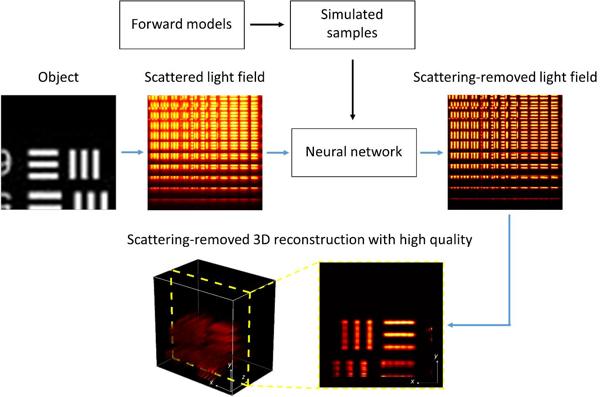Light field imaging is a 3D imaging technology. In light field imaging, the projection of 3D object to light field information on 2D image plane (including spatial and directional information of incident light) will be conducted by micro-lens array. Then 3D reconstruction of object will be realized through the processing of light field information. Light field imaging has the feature of high-temporal-resolution with scanning-free 3D imaging process and has no requirement of special illumination. Therefore, light field imaging has shown significance in research fields and applications, such as biological imaging, industrial measurement and machine vision.
In many application scenes of light field imaging, scattering medium is presented, such as biological tissue, fog and turbid water. Scattering medium will generate spread of light, introduce scattering background noise into light field information and introduce scattering background artifacts into 3D reconstruction. This will seriously reduce the imaging quality.
To solve this problem, the effect of scattering on light propagation can be introduced into the light field imaging forward model to remove the mismatch between the practical imaging scene and the ideal imaging model. Then the scattering background artifact of 3D reconstruction can be reduced significantly. However, the inverse problem solved to realize 3D reconstruction is ill conditioned, and the introducing of scattering effect will increase the degree of ill condition, which leads to the degradation of 3D reconstruction contrasted with the result of scenes without scattering. This also makes 3D reconstruction more severely limited by the sparse of object and the degree of scattering, hindering the further application of light field imaging in related fields. The method of light field imaging through scattering with high quality still need to be exploited.
In recently years, deep learning plays an important role in optical imaging, especially in computational imaging, for its significant performance in information processing. Based on this, a deep learning-based method of scattering removal in light field imaging was proposed and demonstrated by experiment by Professor Xing Zhao's team from Nankai University. Related results are published in Chinese Optics Letters vol. 20, No. 4 (W. Wang, et al., Deep learning-based scattering removal of light field imaging).
In this method, the effect of scattering on light field information is removed by neural network, and the scattering-free light field can be recovered. Then the solving of inverse problem to realize 3D reconstruction will be conducted with the scattering-free light field imaging forward model, this will reduce the degree of ill condition and improving the quality of 3D reconstruction, as shown in Figure 1. In addition, considering the huge workload and difficulty in obtaining of samples in scene of 3D imaging through scattering, the training samples of neural network is generated by the scattering and scattering-free forward model. In this way, the huge workload can be avoided and the problem of obtaining of samples can be solved.

Fig.1 Scattering removing of light field information and 3D reconstruction
The proposed method improves the ability of light field imaging in scattering imaging scenes, such as imaging in vivo and imaging in fog and turbid water, enhances the application values of light field imaging in related research fields. These show the value of further research of the proposed method. In addition, this method also provides practical experience for the application of deep learning in computational imaging. In the future, the research group will further carry out the research of this method in the imaging scenes of strong scattering and thick scattering media, and promote the applications in related research fields.







